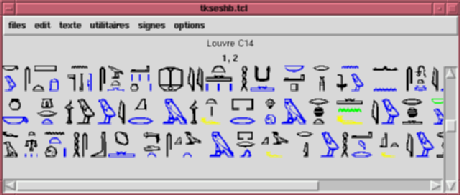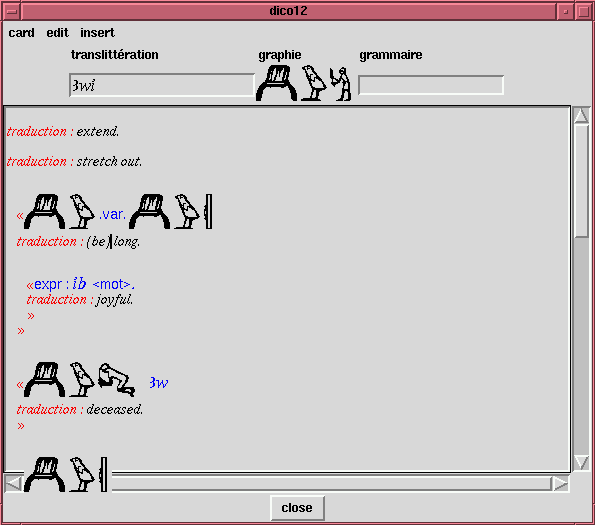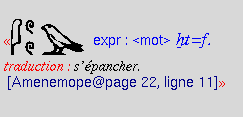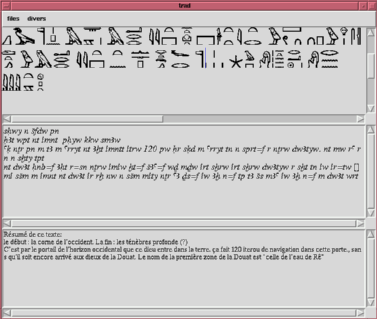TKSESH
A hieroglyphic database system
Équipe EC.art, laboratoire LRIA, Université Paris
8

Abstract
We introduce tksesh, a multiplatform editor, database and
dictionary software. Tksesh is both intended to be a toolkit to build
applications for the philologist and an example of such application.
The core of tksesh is a hieroglyphic editor which understands "Manuel
de codage" encodings. The edited texts can be saved in a database, and
referenced by the dictionary system, via hyperlinks.
The dictionary can handle complex definitions by multiple
authors. Most of the text in the dictionary has precise meaning, not
only for the reader, but also for the computer. This allows automated
treatments and possibly complex searches. An important feature of the
dictionary is that it can contain references to the text database, in
a readable way, and that clicking on these pops up the referenced
text. Of course, exhaustive searches in the database text are also an
option.
The Tksesh system is written in the Tcl/Tk language, which is freely
available for both Windows, Mac, and Unix systems, allowing it to be
very portable.
Introduction
The system we introduce here, called TKsesh, is a multi platform system
(it works under windows 95, Unix, and should work on macintoshes as
well) built around a hieroglyphic editor (compatible with the manuel
de codage), and a database engine.
We started working on it quite a long time ago, but at that time it
was a rather secondary work. Yet, it appeared that the system was
potentially useful. Thus we decided to develop it further. What is
presented here is a preliminary version of the software. We look forward
for opinions and criticisms to improve it.
Context and goals of the system
While working on our computer-science thesis, whose subject was
automatic syntax analysis applied to middle Egyptian, the question
of what was to be done with the texts we worked on was left in the
background. However, we ended up with the idea of an integrated
environment which would allow to store most information one reads
and produce while working on a text, to share them, and, most
important, to retrieve them. The system could also be a testbed
for the Natural Language Processing systems we worked on.
The goal of Tksesh is both to help the realisation of a complete
database of Ancient Egyptian texts, and to be a working tool for
its user, where one can keep notes, lexical files, and so on.
The components of the system
Tksesh is currently an integrated system : a number of quite different
elements bound together in one program. We will now proceed to
describe these elements, starting with the editor.
The editor
The hieroglyphic editor is a central element of tksesh;
its use will be described here, and information on its code will be given in the system's documentation.
The editor's primary function was typing texts for databases, not
for printing. So our primary goal was ease and speed of text
typing, versus accuracy of printed representation.

typing text
As any hieroglyphic editor, tksesh allows entering the signs by a
menu or by code. Simple sign grouping can be done by use of the
Manuel de Codage symbols ":" and "*", which allows fast typing;
but complex grouping is done by menu. So it is impossible to enter
incorrect codes in the system.
The strong point of Tksesh as far as typing goes is that it is
tolerant about codes. When a transliteration is typed, if the sign
is not the expected one, a press on the spacebar will propose a
new sign. For example, if I type "mr", I'll get  . If I want the pyramid-sign (O24), I'll press
"space" a few times, and get
. If I want the pyramid-sign (O24), I'll press
"space" a few times, and get  . Next time I'll
enter "mr", the system will remember it and propose O24 first.
Even better, when the list of possible signs is exhausted, the
system looks in the dictionary, for words
having the said transliteration. Thus, in the present state of
the dictionary, typing "iw" and spacebar will propose :
. Next time I'll
enter "mr", the system will remember it and propose O24 first.
Even better, when the list of possible signs is exhausted, the
system looks in the dictionary, for words
having the said transliteration. Thus, in the present state of
the dictionary, typing "iw" and spacebar will propose : 









 .
.
Grammatical informations
Supporting the grammatical codes of the Manuel de codage
was essential for a system whose primary goal was text
databases. However, there's a problem with the manipulation of
these codes. The display, and in general the way a user manipulate
the text, is cadrat-oriented. Words separations and grammatical
separations are sign oriented. Hence we have two problems : the
first is to design how the user will manipulate the system to add
these informations, and the second is how the system will extract
words and the like.
At the time being, grammatical markers are indicated by sign
colors. Blue signs indicate word endings, yellow signs grammatical
markers, and green signs word endings that are also grammatical
markers (see Figure 1).

FIGURE 1 : WORDS ENDINGS IN LOUVRE C14 STELA
Currently, the user can only change the status of the last sign of
a cadrat, typing "/" to make it a word ending, and "=" to make it
a grammatical ending. If the marking is done at the time the text
is entered, this is not a problem. However, it becomes one when
the marking is done a posteriori. In these cases, one has
to break the cadrats and rebuild them after marking. It is not
convenient. Next version will include a sign-by-sign navigation
mode, which will allow to navigate one sign at a time, and thus to
change the status of the current sign.
A related problem is the difficulty to cut and paste a
word. This possibility is highly desirable, since it would
allow, for example, to add commands like "find the current word in
the dictionary", enter the current word in the dictionary, and
so on. To do this properly, we have to
- be able to designate the current word --- and for this, the good unit is the sign, not the cadrat ;
- be able to build a cadrat from parts of a cadrat.
This is not currently possible, but should be soon.
References
As our goal was to build an "intelligent" text
database system, with hypertext links all over the place, we
needed a way to refer to particular points in a text in an
efficient way.
We thought that readable references, very much akin to those
used while referring to paper editions, would be fine. This has
many advantages. First, it allows the references to be used
outside the base : we support things like "O. DM 1567
verso, 2".
A second point was that long texts are not always entered from
the first line of the first page onward. In fact, you can start
typing an interesting part of a text, enter information in the
base about its contents, and some time later, decide, for
completeness's sake, to type the rest. Our current system allows
to explicitly give the position of the current part of the text.
For example, in Figure 2, the whole
content of P. L2 wasn't entered. But as the first line is
explicitly "page 2, ligne 6", references to parts of
the text will still be exact, even if we type the first pages
afterwards.

FIGURE 2 : EXPLICIT REFERENCES IN A TEXT
In order to create this system while keeping our files "Manuel
de Codage"-compliant, we used the comment system. The first lines
of L2 look like this once saved :
++TKSESH DATABASE FILE+s
++NAME Ptahhotep,L2+s
++COORDS=page 2, ligne 6+s
-i-r-wn:n-n:k\-m-s-.-sSm
Our main problem now with this reference system is to make it
really usable by the end-user. The interface to the
reference-setting system is probably not very user-friendly. As an
example, I give in Figure 3, a picture of
the system for the stela Berlin 1157, from an example file of
Winglyph. The stela has four zones : three called A, B, C; and the
main text below, which is not designated by a letter. So the text
is separated in "lines" (which could be columns), grouped into
zones. The lines are simply numbered (the value NUM for coord 1),
and the zones (usually used for pages) are separated into A, B
etc. Hence the numbering system is A1, A2, B1, C1, 1, 2, etc.

FIGURE 3 : REFERENCE CREATING SYSTEM
Further needs
The main shortcomings of tksesh's editor stand in the domain of
presentation. Improved cadrat rendering and column handling would
be nice. More seriously, a font editor is absolutely necessary. We
have already written one, but it runs only under UNIX, and thus
can't be integrated in the whole system.
Another interesting addition would be the support of multiple
reference systems. It might be interesting, for example, to be
able to chose between a reference in the original source, or a
reference in an edition (That is, for example, between
P. Leyde I 350 verso 13 and KRI II,813,3).
The dictionary
Introduction
When we decided to transform tksesh into a work environment for
studying texts, the need for a linked dictionary arose naturally.
In the first version of the dictionary, entries were quite simple
: three fields : "transliteration", "spelling", "translation", the
latter being free text. We included also the possibility to add
hypertext references to the text database.
However, a real dictionary entry is something both complex and
very structured. Entering it as free text is not a very good
option, because the structure is lost to the computer. The human
reader might be able to reconstruct it, the system won't. Many
automated processing that would be possible with a well
structured lexicon are then impossible.
On the other hand, giving a very precise and rigid form to the
dictionary would also be a problem, because it would force an
artificial structure on all definitions.
Last, but not least, the structure proposed should be
extensible, but no extension should break existing data.
Hence the structure we are going to describe now. This structure
is supported by the editor built in the dictionary, which
prevents unstructured entries to be made. It allows to enter
many different style of dictionary entries, while keeping the
maximum amount of structure information. We tested it by
entering definitions from GARDINER's lexicon, FAULKNER, HANNIG,
and of P. WILSON's A Ptolemaic
Lexicon.
Structure of the dictionary
The fields in the dictionary are of roughly three types : base
fields, which contain one type and only one type of information
(for example, a transliteration), complex fields, that can
contain mixed information (for instance text in transliteration
and hieroglyphs), and the group and comment fields.
The group field
The group field is the main organizational device of the
dictionary. Groups can be nested, to represent sub-meaning of a
words, derived words, and so on. The basic point is that if a
group contains multiple fields of the same kind, let's say
multiple transliterations, they are supposed to be variants. In
the case of translations, this would mean near-synonymous
meanings.In Figure 4, all spellings for
ip.t are supposed to be equivalent. In a likewise case,
the completion system described above
should be able to propose all these writings.

FIGURE 4 : REPRESENTATION OF VARIANT SPELLINGS
When some important information (transliteration, spelling, for
example) is not available in a group, it is supposed to be
inherited from its parent group.
Let's take, for example, the entry for Awi
(Figure 5,). The groups (indicated by
french quotes << >>) delimit a
number of new entries. The first one is for the adjective-verb
meaning be long, which has the same transliteration as
the head word, but different determinatives. It inherits its
transliteration, but changes the translation and the spelling.
Then comes the expression "ib=f Aw". Expressions and composite
words are a tricky problem, whose representation might need some
improvement. At the time being, we have a number of tags that
can be used in expressions to represent the currently defined
word, an animate, or an inanimate. The other words might be free
text, or explicitly transliterations of words (in which cases
they are indexed. For instance, in the current case, a search
for the word "ib" will retrieve this definition).

FIGURE 5 : COMPLEX DEFINITIONS
The comment field
In some cases, a dictionary
definition can be a true little monograph on a word. In this
case, the dictionary entry structure is not very efficient. This
is the reason for the comment field's existence. It is there for
anything that can't fit in a definition. Many fields can appear in
it, like in a true little text editor.
References
References are hypertext links to the text
database. They are readable by the human reader, like in the
example on the right, taken from Amenemope.  These links are made quite
easily, by using the "copy reference" menu option in the editor,
and pasting the reference in the dictionary. Afterwards, a click
on the reference will load the text at the proper place.
These links are made quite
easily, by using the "copy reference" menu option in the editor,
and pasting the reference in the dictionary. Afterwards, a click
on the reference will load the text at the proper place.
Signature
An important feature for further use of the
system will be the possibility to share texts and dictionary
entries, and conversely to identify the author of these
entries. The Signature field is supposed to be used for this. A
further development would be to fill it automatically -- at least, at data exchange time.
Indexation and search
The system builds an index for each
dictionary entry, into which it writes references for each
transliteration, spelling, and translation. Any field of these
types in dictionary entries is indexed, so even sub-definitions are entered in the database.
An important practical point is that text is treated to ease the
search. For example, the hieroglyphs are save as Gardiner code,
no matter their original form, and only the list of signs is
saved. So, someone looking for "p*t:pt" and typing "p:t-pt" will
find his word. The transformation could even be improved by
suppressing redundant phonetic complements and the like, but this
is future work.
Transliteration are also simplified for searches : all 'j' are
made into 'i', all points suppressed, etc. Note that this is only
made at search time. Any point entered in the dictionary entries
will be retained.
Extensions
Looking at the current state of the
dictionary, we see a possible generalization : the same mechanism
can be used for freer text, for example for notes and the like. So
we intend to reuse the code for the dictionary to allow the
edition of general notes, which will benefit from the indexation
mechanism of the dictionary.
Another interesting extension would be to add an reference
system to parts of the dictionary. This would allow referencing
a definition in another one. It would be very interesting in
expression definitions, as it would allow to reference in a
precise and explicit way the words which appear in the
definition.
The transliteration and translation editor
This facility will be a central working point of the system once
finished. What we present now is just a model. It allows parallel
edition of the text translation and transliteration, which can be
saved separately. The advantage is that this allows multiple
translations to be edited for one text.

FIGURE 6 : TRANSLATION EDITOR
In the editor, all texts are synchronized : the edited line is
always displayed in translation, transliteration, and
hieroglyphs. We worked a little with the model, and it seems to be
quite suitable. We linked it with the dictionary, and it is now
possible to look for the word selected in the hieroglyphic window.
Search facilities
One of the most important facility a database can provide is the
possibility to retrieve the information it contains. So our base
allows to find a words (given in transliteration) in the
texts. For texts which have been manually transliterated, it
should look in the man-made transliteration, because it's
supposed to be accurate. But (as we'll see later), we have a
automatic transliteration program that produce a rough
transliteration. It's quite fast on a basic Pentium computer, and
can be used if no time is available to write a
transliteration. The search made in this case is not complete nor
sure : some occurrences might be lost, and some words founds can
be errors. Yet, it can give a fast initial working base, and it
should improve with our transliteration system.
In Figure 7, we have the result of the search for the word
Axt, and an example of a solution.

FIGURE 7 : SEARCH RESULT
Natural Language processing
The system includes (currently only in its UNIX version) a prolog
interpretor which allows us to use natural language processing
techniques more easily. We had sketched in [ROS94] a transliteration system. After having
worked more on syntactic analysis problems, we had a student,
L. KERBOUL, working on the subject . [KER97]. As the result was interesting, we
decided to work again on transliteration, and if possible, to end
up with a usable system. A detailed technical description does not
fit here; let's only say that the basic principle is still the one
described previously, but the performances have much improved. The
main problem now is word cutting, which is a difficult
problem. For this, the best solution would be an interactive one,
the system proposing word-cuttings, and the user changing them. It
is, interestingly, the solution used by some in editing Asian
language (an example for Thai in MCB97)
Further developments
The developments axis of the system will be :
- improvement of the editing system
- improvement of the natural language processing system -- ultimately with the incorporation of grammatical information
- creation of an exchange module --- to allow easy information sharing and exchange, using disks or even the net.
Conclusions
The system I've just described is still in his infancy. Its
foundations are however quite sound, and it works well. Now what it
needs is users, to make it live, to propose friendlier interfaces,
and useful additions.
Appendix
TCL and TK
TCL/TK is a programming language developped by John
OUSTERHOUT at Cambridge University (USA) and then
in the SUN research department. It is a simple, powerful,
cross-platform language, specially designed to be embedable in
programs written in compiled languages like C or Pascal. Tksesh is
based on a number of extensions, written in C, to TCL/TK. It runs
under UNIX and Windows 95. Due to the flexible nature of TCL, it
is possible to use tksesh to write little application that would
need to display hieroglyphs.
Availability
The system will be available free of financial charges, as "textware":
if the system is of some use to you, please contribute some texts. It
would be definitly better to ask which texts are needed before sending
them.
At the time being, the software is quite young, and has had very
few users. For this reason, I don't release it by simply putting
it on a ftp server. You will have to register first. The details
about obtaining the system will be available by next autumn on
http://www.iut.univ-paris8.fr/~rosmord/EgyptienE.html.
References
- BIL95
S. BILLET, 1995,
Apports à l'acquisition interactive de connaissances
contextuelles
Thèse de doctorat de l'Université Montpellier II
(another approach of automated translitteration).
- KER97
F. KERBOUL, 1997,
Translittération automatique des hiéroglyphes
Rapport de stage de l'ENSTA
- MCB97
S. MEKNAVIN,
P. CHAREONPORNSAWAT and
B. KIJSIRIKUL,
1997,
Feature-based Thai Word Segmentation
In Natural
Language Processing Pacific Rim Symposium 1997, Phuket,
Thailand
- ROS94
S. ROSMORDUC, 1996,
Traitement automatique du langage naturel en moyen égyptien
In Robert VERGNIEUX, editor,
Xieme conférence Informatique et Égyptologie
- ROS96
S. ROSMORDUC, 1996,
Analyse morpho-syntaxique de textes non ponctués
Thèse de doctorat, École normale supérieure de Cachan,
Serge Rosmorduc

 . If I want the pyramid-sign (O24), I'll press
"space" a few times, and get
. If I want the pyramid-sign (O24), I'll press
"space" a few times, and get  . Next time I'll
enter "mr", the system will remember it and propose O24 first.
Even better, when the list of possible signs is exhausted, the
system looks in the dictionary, for words
having the said transliteration. Thus, in the present state of
the dictionary, typing "iw" and spacebar will propose :
. Next time I'll
enter "mr", the system will remember it and propose O24 first.
Even better, when the list of possible signs is exhausted, the
system looks in the dictionary, for words
having the said transliteration. Thus, in the present state of
the dictionary, typing "iw" and spacebar will propose : 









 .
.





 These links are made quite
easily, by using the "copy reference" menu option in the editor,
and pasting the reference in the dictionary. Afterwards, a click
on the reference will load the text at the proper place.
These links are made quite
easily, by using the "copy reference" menu option in the editor,
and pasting the reference in the dictionary. Afterwards, a click
on the reference will load the text at the proper place.

